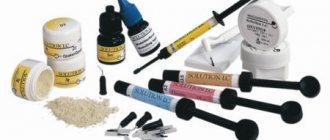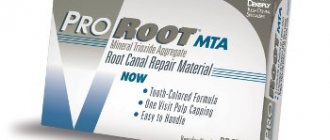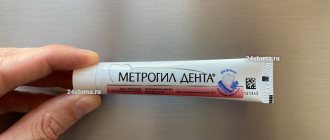Foredent is a material based on resorcinol-formalin resin, used for permanent filling of tooth root canals. Available in the form of powder and liquid, which when mixed form a special paste with a disinfecting effect, from which permanent fillings are made. Sealer Foredent is the simplest and most affordable product, used everywhere in most clinics in the CIS.
Key features of the material
The substance is produced by a Czech company – Spofa Dental. The product is fully certified and safe for use according to all European standards. The main components of the drug are resorcinol and formaldehyde. These components are included in a set consisting of 40 grams of powder mixture and two containers with liquids of 25 grams each.
The dental product Foredent is a material that has long proven itself to be simple and easy to use. A filling preparation created on the basis of resorcinol-formaldehyde resin has a huge number of advantages when working:
- easy to process;
- remains unchanged in volume;
- fits well into the canal;
- has a strong disinfectant effect;
- radiopaque;
- guarantees reliable tightness of the sealed canal.
The paste hardens in about an hour. The filling mixture becomes completely hard within a week.
The manufacturer of the drug recommends storing Foredent in a cool, dark place at temperatures from +5 to +25C.
Phenoplast
Properties and applications of cellular polypropylene
Phenolic plastics are used for the manufacture of various products by direct compression using heat. Some phenolic plastics are used for injection molding and extrusion.
Phenoplastics are divided into grades depending on their constituent components.
Phenolic plastics are a pressed material mainly made from phenol-formaldehyde resin with fillers.
Phenoplastics are divided into powder, crumb-like, fibrous and layered.
Phenolic plastics are a pressed material mainly made from phenol-formaldehyde resin with fillers. Phenoplastics are divided into powder, crumb-like, fibrous and layered.
Phenoplastics - polymers based on phenol-formaldehyde resins - are produced with organic or mineral fillers.
Phenolic plastics are produced industrially in the form of press powders, fibrous and layered materials.
Phenolic plastics have satisfactory dielectric properties (especially if the filler is quartz flour), successfully combined with high heat resistance.
Phenolic plastics (based on phenol or cresol) are produced in the form of corrugated sheets, plates, etc., do not get wet, do not corrode, and are cheaper than metal.
Phenoplastics reinforced with organic and inorganic fibers are successfully used in rocket science as materials with ablative properties.
Phenolic and amino plastics are injection molded on presses, like thermoplastics.
Phenoplastics with organic fillers are allowed for long-term operation 100 - PO 1 C, for a short time ... Zi C with the same additional shrinkage as indicated above. Phenolic plastics, manufactured in accordance with GOST 5689 - 60 of seven types, are widely used as electrical insulating and structural insulating plastics in instrumentation and apparatus manufacturing. Each type is divided into groups. Type O for general technical purposes contains wood flour as a filler; group 04 - impact-resistant, has a rubber-modified resin as a binder. Type E - electrical insulating is made with mineral fillers, both with modified resol resin (EZ group) and with unmodified resins. The HF high-frequency type is manufactured, like the E type with mineral fillers, on a modified resin. Type Bx moisture-chemical-resistant is manufactured with different fillers and resins. Type VL - impact-resistant, coarse-fiber, made with organic long-fiber filler and asbestos fiber. Type Zh - heat-resistant, used for electrical installation parts with mineral filler.
Phenolics with organic fillers allow long-term operation at 100 - 110 C, short-term operation at 115 - 135 C with the same additional shrinkage as indicated above. Phenolic plastics, manufactured in accordance with GOST 5689 - 66 of seven types, are widely used as electrical insulating and structural insulating plastics in devices and apparatus manufacturing. Each type is divided into groups. Type O - general purpose, made from novolac resin and contains wood flour as a filler; group 04 - impact-resistant, has a rubber-modified resin as a binder. Type Sp is a special ammonia-free type, made from resole resin with wood flour with and without certain electrical insulating properties. Type E - electrically insulating, made from resole resins with both wood flour and the addition of a mineral filler. HF type - high frequency, made of resol and novolac modified resin with mineral fillers. Type Bx - moisture-chemical resistant, made from novolac resins with different fillers. Type VL - impact-resistant, coarse-fiber, made from resol resins with organic long-fiber filler and asbestos fiber. Type Zh - heat-resistant, made of novolac resins with mineral and mixed fillers.
Phenolics are very common thermoset plastics made from phenolic resins, often called bakelites. Phenol is isolated from coal tar and is also obtained synthetically from benzene.
Phenoplasts and aminoplasts with organic fillers are unstable to the action of alkalis, and getinax is much less resistant than textolite. At the same time, phenoplasts resist the action of weak hydrochloric and sulfuric acids much better. Phenolic and amino plastics are highly resistant to gasoline, transformer oil and sea water.
Instructions: Foredent
The most important substance of the drug, resorcinol-formaldehyde resin, is a toxic substance that causes negative consequences if inhaled or in contact with open skin and mucous membranes. For safety reasons, the tooth to be filled must be completely isolated from neighboring tissues. To achieve this, dentists use rubber dam substances.
Installed rubber dam on a tooth
Work with Foredent substance only with gloves and in a well-ventilated area. If the drug gets on the skin or mucous membranes, it is necessary to treat the area with water as soon as possible.
Processing into products
Izolon PPE: properties, advantages and scope of application of the material
The production of products from thermoset plastics is mainly carried out using injection molding or direct pressing methods. A more modern method is injection molding, which differs from traditional thermoplastic molding by the presence of a heated mold, not a cooled one, operating in the range of 160-210 degrees C.
With all these methods, a chemical reaction of cross-linking macromolecules takes place in the polymer, called curing. It usually takes minutes or even hours to complete the chemical curing interaction of the molecules. The technological process is complicated by the risk of early curing of the thermosetting resin, so the temperature regime for pressing and especially casting must be maintained accurately. In addition, precise dosing of the polymer mixture and its rapid injection into the mold is necessary due to the very short time possible for thermosets to be in a viscous-flowing (molten) state.
Products made from thermoset polymers after molding are suitable for post-processing by mechanical methods, as well as for joining with other products or materials using adhesives. In the case of a low degree of cross-linking, it is also possible to weld such products chemically.
Restrictions and contraindications
Foredent tends to change color over time, so its use on the front teeth is undesirable. Pink-brown areas on the front incisors look extremely unsightly. Such a defect can only be eliminated using camouflage agents such as veneers and lumineers.
Resorcinol-formaldehyde material must be used extremely carefully, taking into account all the nuances. When toxic components get on various tissues, they have a harmful effect on them. Formaldehyde, which is part of Foredent, tends to permeate tissues and penetrate beyond the boundaries of the tooth, so it is necessary to carry out isolation very carefully.
Potent substances that enter the oral cavity and respiratory tract lead to negative consequences, so strict adherence to the marginal seal of the filling is required. Substances in Foredent may be allergens, so it is necessary to clarify whether the patient is allergic to the components of the drug. A person may experience a reaction to toxic substances if the paste gets beyond the apex.
The cavity is filled with Foredent only up to the apex.
Opinion about the drug
The use of resorcinol-formaldehyde substances in modern practice raises much debate about the safety and appropriateness of their use. Some dentists call this mixture very dangerous for the human body. The main materials used are highly toxic. Filling pastes have mutagenic properties and have a teratogenic effect. Formaldehyde has the ability to spread throughout the body and gradually poison it. Teeth filled with resorcinol-formaldehyde resins cannot support dentures.
For a very long time, dental canal fillings have been performed using resorcinol and formaldehyde. Over many years, the manufacturer has learned to make the safest drug, Foredent, that meets all standards. It is one of the most common dental materials in the world. All components and quality of the paste meet all European standards. Foredent is certified and recognized by leading dental clinics in the world.
Where is polypropylene used?
Basic properties of building materials: mechanical, physical, chemical and technological.
classification of building materials and innovations in modern construction Polymer synthetic material can replace expensive analogues, allowing to reduce labor and material costs. Therefore, it is effectively used in a variety of fields.
Food industry
In the manufacture of plastic bottles, dishes, lids, cling film, packaging containers (the polymer ensures low material consumption). Despite the fact that the products have minimal thickness, their shape remains durable.
Artificial threads
Strong, heat-resistant, elastic fibers are obtained from synthetic plastic (more products are obtained from 1 kg of the substance than from the same amount of another polymer). The disadvantage of special threads is their vulnerability to ultraviolet radiation. The introduction of modified additives makes it possible to increase its chemical properties. Ropes, ropes, twines are effectively used in the field of shipbuilding.
Machinery and instrument making
The high wear resistance of the material determines its widespread use in production:
- parts for fans, cooling systems, vacuum cleaners, refrigerators;
- fuse blocks;
- shock absorbers;
- filters;
- battery tanks;
- seals for body parts;
- bumpers;
- dashboard;
- floor mats, etc.
Pharmacology
Polypropylene is successfully used in medicine - it is used to make inhalers, syringes and other medical supplies that can be steam treated (sterilized):
- test tubes;
- sample and IV bottles;
- baths;
- Petri dishes;
- containers for tablets;
- elements of diagnostic devices.
Electronics
Thermoplastic material ensures high quality:
- insulating shells;
- coils;
- telephone sets;
- housings for televisions and radios;
- communication wires.
Package
Thermoplastic polymer films are a popular packaging material with high performance properties. Flexible, transparent, easily weldable and non-toxic, the films are sterilization and chemical resistant, making their value in the medical and food industries undeniable.
They are used as bags for packaging fruits, berries, vegetables, confectionery and bakery products, bulk products for transportation and storage. PP packaging is convenient, roomy, and lightweight.
An innovation in the packaging industry is specially oriented films that have increased transparency, rigidity, strength and moisture resistance. Glossy products successfully replace label paper.
Use of polypropylene in everyday life
- plastic furniture;
- carpets;
- dishes;
- oilcloth;
- toys;
- buckets, basins, flower pots;
- soap dishes;
- vegetable boxes;
- flasks;
- bags, garbage bags;
- disposable diapers and other household items.
Modern manufacturers choose PP as an alternative to other materials due to:
- environmental friendliness;
- cost;
- ease of disposal and recycling.
It is believed that the scientific potential of the thermoplastic synthetic substance has not been fully realized.
Price Foredent
The price of Foredent varies. On the Internet, the cost of one set, consisting of 40 grams of powder and two containers of liquid of 25 grams each, ranges from 339 rubles to 473 rubles. In Russia, the average price of filling material is 400 rubles. In Moscow pharmacies, the cost of Foredent can reach up to 600 rubles.
Methods for producing phenolic plastics and processing them into products
The filler for press powders, such as phenolic plastics, is most often wood flour, much less often fine-fibered asbestos. Mineral powder fillers used include fluorspar and dusted quartz.
Press materials such as phenolic plastics are produced using “dry” and “wet” methods. With “dry” methods, the resin is used in dry form, and with “wet” methods in the form of an alcohol varnish (varnish method) or a water emulsion (emulsion method).
Processing of phenolic plastics into products is carried out in various ways. The oldest and most common industrial method is direct pressing (also called hot or compression pressing) applicable to all types of press materials described.
The injection molding method, also called transfer or spritsguss, is used only for processing press powders when the product must include complex fittings.
The continuous extrusion method is used for the manufacture of various profile products from press powders (tubes, rods, corners).
Analogues of Foredent
There are many analogues of Foredent on the market. The most common of them:
- Resorcinol is a Russian analogue based on formaldehyde components. Manufactured by Omega.
- Rezodent is a preparation with a disinfectant effect used for disinfection of root canals and fillings. The composition includes an x-ray contrast filler and resorcinol with special additives. Produced in Belgorod. Price from 130 rubles.
- Forfenan is a French analogue for filling infected canals. The price of the set is from 5,000 rubles.
Foredent has been the main material for filling root canals for many years due to its reliability, ease of use and availability. Analogs on the market are either too expensive or not as versatile and easy to use.
Purposes of use
Foredent is well suited for filling root canals after pulp removal. Intended for use in periodontal treatment and for the manufacture of fillings relating to the apical foramen (foramen apicale).
Filling material can also be used for additional surgical procedures (alveolotomy, root tip resection, periapical curettage).
Application of Foredent in dentistry
After depulpation, Foredent is most often used as a filler for the root canals of the tooth. It is also used in the treatment of periodontal disease with the installation of a filling in contact with the apical foramen. Material based on resorcinol-formaldehyde is often used for indirect third-party interventions: periapical curettage, dissection of the wall of the tooth alveolus, resection of root tips.
Application
Parts made using phenol-formaldehyde polymers
Used to produce plastics (hardened resins are called resites
, cured in the presence of petroleum sulfonic acids -
carbolites
, lactic acid -
neoleukorites
), synthetic adhesives, varnishes, sealants, switches, brake linings, bearings, also widely used in the manufacture of billiard balls. The housings of Soviet multimeters of various models were made from carbolite.
Used as a binding component in the production of filled press compositions with various fillers (cellulose, fiberglass, wood flour), wood-fiber and particle boards, impregnating and casting compositions (for plywood, woven and fiber-filled materials).
For a number of properties, plastics based on phenol-formaldehyde resins still remain an unsurpassed material. They are used to produce:
- Parts for a wide range of mechanical engineering products, steps for escalators in the subway, handles for tools, etc.
- Abrasive tools, brake pads for subway cars.
- Electrical products - plugs, sockets, switches, electric meters, electric irons, electric motor housings, relays and magnetic starters, terminal boxes, etc.
- Cases of various devices - telephones, radios, cameras; parts of electronic equipment elements - radio tubes, cathode ray tubes, capacitors, etc.
- Details of weapons and military equipment.
- Elements of kitchen utensils: handles for knives, frying pans, pots and kettles, gas stoves.
- Plywood and particle boards (binding material). Furniture parts and furniture fittings.
- Getinax is a material for the manufacture of printed circuit boards.
- Textolite is a material for the manufacture of printed circuit boards and a structural material.
- Checkers, chess, dominoes and other inexpensive elements of board games.
- Souvenirs, stationery, jewelry, watches.
- Glues and varnishes, for example, BF glue.
- Ablative protection of descending spacecraft.
Environmental aspects
Toxic materials are used in production. Both phenol and formaldehyde are poisonous and flammable. Formaldehyde has a carcinogenic and also depressant effect on the nervous system.
Phenol-formaldehyde resins can be harmful to the skin and can cause dermatitis and eczema. Uncured phenol-formaldehyde resin can contain up to 11% free phenol.
When phenol-formaldehyde resins are cured in plastic (phenoplasts), cross-linking of oligomeric fragments of the resin occurs with the participation of the free phenol contained in it, while the content of phenol incorporated in the phenol is reduced to trace amounts; sanitary standards of the Russian Federation regulate the permissible amounts of migration of phenol and formaldehyde for products made of phenolic plastics; in particular, for products in contact with food for phenol - 0.05 mg/l, for formaldehyde - 0.1 mg/l.
A big problem is the difficulty of recycling or reusing phenol-formaldehyde products.
Typical representatives
If among thermoplastic polymers you can find such well-known materials as polyethylene, polypropylene, PVC, polystyrene, PET and so on, then thermosets are now less known. This fact is especially interesting in view of the fact that in the mid-20th century, thermoset polymers were used more widely than thermoplastic plastics. Even in the 1980s and 1990s, plastics processing departments spent more time on compositions based on curable resins, their modifications and the production of products from them. This fact is due to the fact that, although the most important thermoplastics were obtained a very long time ago (many are more than 100 years old), brands with valuable, especially strength properties, did not exist for a long time.
The most widely used in modern industry are thermosets based on polyester, phenol-formaldehyde, epoxy, aminoaldehyde and urea resins.
Fig.1. Epoxy adhesives are one of the main applications of thermosetting resins
Thermoset compositions generally consist of a binder and fillers. The binder is directly a thermosetting polymer (resin), examples of such polymers are phenol-formaldehyde, urea-formaldehyde and melamine-formaldehyde, epoxy, polyester, etc. The fillers used for thermosetting polymers are generally the same as for thermoplastics: chalk, talc, wood flour, fiberglass, but woven and fibrous materials such as cotton and other fabrics, cellulose, and long fibers from various materials are more often used.









